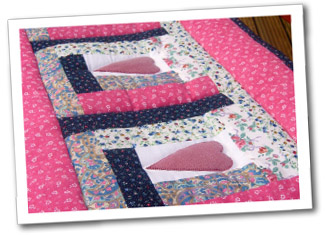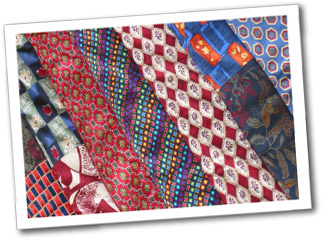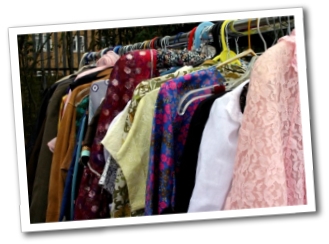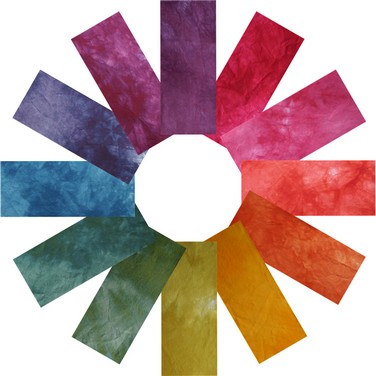Textiles

Always use good-quality fabrics for your sewing projects. This doesn't mean you have to buy new fabrics.
You can buy good quality fabrics cheaply at your local charity shop or even more cheaply at your local car-boot sale. You can even obtain fabrics for FREE by recycling your family's cast-offs (shirts, trousers, ties, etc.).
Once any damaged portions (like collars and cuffs) are removed, the rest can be cut into basic squares and strips and used as patchwork fabrics for making quilts, cushions or other textiles.

Recycling Fabrics
I believe in recycling fabrics, where possible. If you can source good-quality fabric from your family's cast-offs, you obtain your raw fabrics for FREE, with the added bonus of making new items with personal and memorable associations from favourite old garments.
Fabrics recycled in this way allow you to create a unique and personal gift for someone who perhaps wore the original garment or who knew the original owner.
Save Your Favourite Shirts
Recycling fabics is a great idea and not just for reasons of nostalgia. Many designer clothes, and other good-quality garments, are discarded because of worn collars, frayed cuffs, ripped pockets, missing buttons, etc. Often there's a great deal of useful fabric left in the main body of shirts, and other garments, that can be rescued and re-used.
Don't Throw Away Your Designer Denims and Silk Ties
Denim jeans are another plentiful resource that can be used to great effect when designing a modern cushion or quilt cover. Once they're washed and cut into squares or strips, there's no telling where they came from and there's no end to what they can be used for.
Even silk ties can be used to create a striking patchwork garment by unpicking them and creating regular sized strips which are then be interleaved to create stunning and colourful designs.
Style Endures - Fashion Fades
It's a shame to simply discard a garment, especially when it contains high-qualty or vintage designer fabric that could so easily be used again. If you choose your fabrics wisely, items made from them can look better and last longer than mass-produced alternatives purchased on the High Street.
If you want to know more about recycling fabrics and need some patchwork sewing ideas, I have written a book called How to Sew with Confidence, which goes into more detail about the processes and techniques.
Finding Bargains
Car-boot sales and charity shops are great places to pick up classic fabrics at bargain prices. They are also a good for picking up second-hand craft books for ideas and inspiration.
How to Spot a Bargain
 Naturally, as with antiques and other second-hand items, you need a discerning eye to spot the bargains. Always look for: Naturally, as with antiques and other second-hand items, you need a discerning eye to spot the bargains. Always look for:
- a label you can trust.
- large sized shirts.
- good-quality fabrics.
- classic/traditional/vintage designs.
- white cotton fabrics (sheets, shirts, skirts and other garments) suitable for hand-dyeing.
Preparing Your Fabrics
When you get your bags of garments back home, it's a good idea to have a closer inspection, to check that they are indeed the bargains you thought they were. You will, of course, need to wash and iron them before you begin the task of cutting them up into squares and strips, which is best done with a rotary cutter, a ruler and cutting mat. If you're going to prepare many such strips, it's also a good idea to separate them into colour drawers or shelves (all the blues together, all the reds together, etc.) so that you can easily find the colour you want when you want to use them.
With the patchwork fabrics being so expensive, a little time - and a few pence - spent at a charity shop or car boot sale is well rewarded and will help keep your hobby affordable.
For further information on how to cut up a shirt, and to get as many patchwork squares and strips as possible, see my videos and tipsweb pages.
If you want to know more about recycling fabrics and need some patchwork cushion ideas, I have written a book called How to Design & Make Fabuous Cushions, which goes into more detail about the processes and techniques.
Hand-Dyed Fabrics
One of my other passions is making my own hand-dyed fabrics. I love the variation of colours that can be achieved within a single piece. This comes in very handy when making items with a natural theme, such as my Boston Ivy Wall Hanging, shown below. The variations in colour make the dyed fabrics ideal for creating images of nature (autumn leaves, blue skies, etc.).
The Dyes and Fabrics
I use Procion MX reactive dyes to create a full colour-wheel of fabrics. Mercerised, good-quality cotton fabrics are also essential as the basis for colour experiments.
The Colours
After much experimentation I have discovered the 'formula' or 'mix' of base colours that I needs to achieve consistent results.
Curing and Scouring
The dyeing process involves soaking the pre-cut fabric in a soda-ash fixative and 'curing' it overnight in a dye solution. The fabric is then rinsed and 'scoured' in a washing machine (at 60 degrees) to remove any excess dye molecules and make the fabric 'colour-fast'.
If you want to know more about dyeing, I have written a book called How to Dye Your Own Fabrics, which goes into more detail about the processes and techniques.
|



 Naturally, as with antiques and other second-hand items, you need a discerning eye to spot the bargains. Always look for:
Naturally, as with antiques and other second-hand items, you need a discerning eye to spot the bargains. Always look for:

